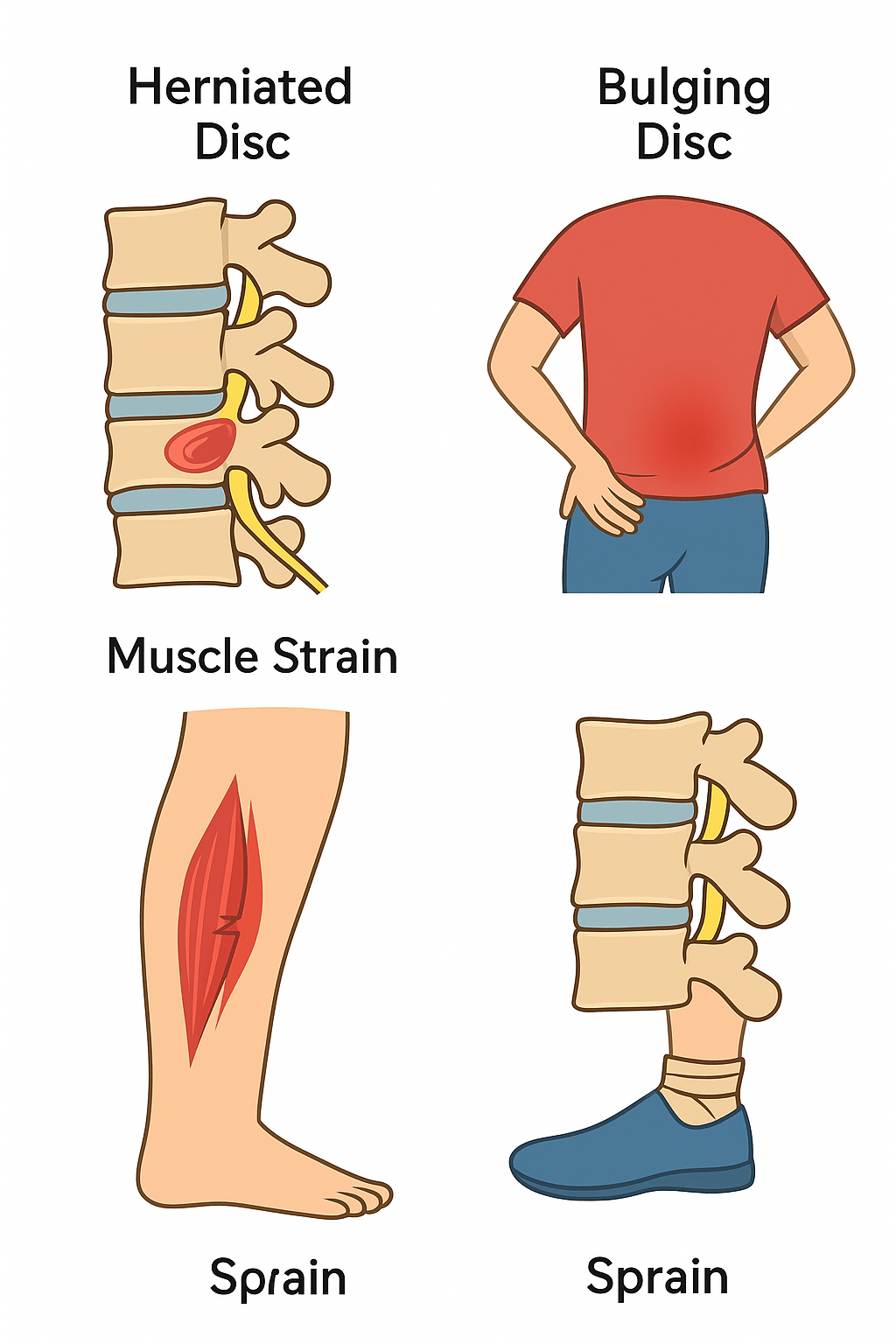If you’re experiencing persistent back pain, leg numbness, or sciatica, a herniated or bulging disc could be the cause. These conditions are more common than you think and can significantly impact your mobility and quality of life.
In this article, we’ll explain what disc herniation is, how it differs from a bulging disc, and how physiotherapy can help you recover—without the need for surgery.
What Is a Herniated Disc?
A herniated disc—also known as a slipped or ruptured disc—happens when the soft, jelly-like center of a spinal disc pushes through a tear in its tougher outer layer. This protrusion may compress nearby nerves, leading to symptoms such as pain, tingling, and muscle weakness.
Herniated Disc vs Bulging Disc: What’s the Difference?
A bulging disc occurs when the outer disc layer bulges outward into the spinal canal but remains intact. It’s usually a result of aging or spinal wear and tear.
In contrast, a herniated disc means the disc’s inner contents have broken through the outer layer, typically causing more noticeable and painful symptoms. Both conditions can irritate nearby nerves and lead to conditions like sciatica.
Symptoms You Shouldn’t Ignore
The symptoms vary depending on the severity and location of the disc issue. Common signs include:
Pain radiating down the leg (sciatica)
Tingling or numbness in the leg or foot
Muscle weakness or difficulty walking
Pain that worsens with sitting, bending, or coughing
Reduced leg reflexes
These symptoms may come and go or become persistent. If left untreated, they can interfere with daily activities and mobility.
How Physiotherapy Can Help Herniated or Bulging Discs
Physiotherapy is a proven, non-invasive treatment option for disc-related problems. A skilled physiotherapist will assess your condition and design a tailored program to:
Alleviate pain and inflammation
Improve spine alignment and mobility
Strengthen core and back muscles
Enhance flexibility and function
Prevent recurrence through posture and ergonomic advice
Common techniques include:
Manual therapy
Joint mobilisation
Electrotherapy
Stretching and strengthening exercises
Soft tissue release
Bed mobility training
Pain education and self-management strategies
When to Seek Help
If your symptoms persist beyond a few days or worsen with time, don’t wait. Early intervention is crucial in preventing long-term complications and ensuring a quicker recovery.
Take Control of Your Recovery
Disc herniation and bulging discs can be effectively managed with the right care. Physiotherapy offers a safe, personalised approach to help you regain comfort and confidence.
Need help managing back pain or sciatica?
Contact our clinic today to book your assessment with an experienced physiotherapist. Let’s work together toward a pain-free, active lifestyle.
Strains and Sprains: Causes, Symptoms & How Physiotherapy Can Help
Strains and sprains are among the most common injuries—whether you’re an athlete, a weekend warrior, or someone who simply moved the wrong way. These injuries can range from mild discomfort to severe limitations in movement and function.
In this post, we’ll focus on muscle strains—what causes them, what symptoms to look out for, and how physiotherapy plays a key role in a safe and effective recovery.
What Is a Muscle Strain?
A muscle strain, often called a “pulled muscle”, occurs when muscle fibres are overstretched or torn. This can happen suddenly during intense activity or gradually from repetitive use. Muscle strains may affect any part of the body but are most common in the lower back, neck, shoulders, and hamstrings.
These areas are particularly prone to strain due to poor posture, heavy lifting, sports activity, or sudden awkward movements.
Sprain vs. Strain: What’s the Difference?
It’s easy to confuse these two terms:
A strain involves muscles or tendons (the tissues connecting muscles to bones).
A sprain affects ligaments, which connect bones at a joint.
While both involve overstretching and tearing, treatment and recovery plans can differ.
Common Symptoms of a Muscle Strain
If you’ve strained a muscle, you may experience:
Sharp or aching pain in the muscle, especially when moving or stretching it
Swelling, bruising, or tenderness in the affected area
Muscle weakness or a limited ability to use the muscle
A “popping” or snapping sensation at the moment of injury (often in more severe strains)
Reduced range of motion
In mild cases, symptoms may improve with rest, but ignoring moderate to severe strains can lead to further damage or chronic issues.
How Physiotherapy Helps You Recover from Strains & Sprains
Physiotherapy is essential in helping you heal properly and regain strength, flexibility, and function. Depending on the severity of your injury, a tailored treatment plan may include:
Pain relief techniques (e.g. ice/heat therapy, electrotherapy)
Manual therapy to reduce muscle tension and improve mobility
Stretching and strengthening exercises to restore muscle function
Activity modification advice to prevent reinjury
Education on posture, movement patterns, and injury prevention
Physiotherapists ensure you’re not just recovering, but also addressing the root causes—like muscle imbalances, poor biomechanics, or inadequate warm-up routines.
When Should You See a Physio?
If pain persists, you’re unable to move the affected muscle properly, or the area is severely swollen or bruised, it’s important to consult a physiotherapist. Early intervention reduces recovery time and lowers the risk of long-term complications.
Final Thoughts
Muscle strains are common but treatable. With the right care—including physiotherapy, proper rest, and guided rehabilitation—you can return to your daily activities or sport safely and confidently.
Feeling the effects of a pulled muscle?
Book an appointment with our physiotherapy team today and take the first step toward a stronger, pain-free recovery.

Leave a Reply